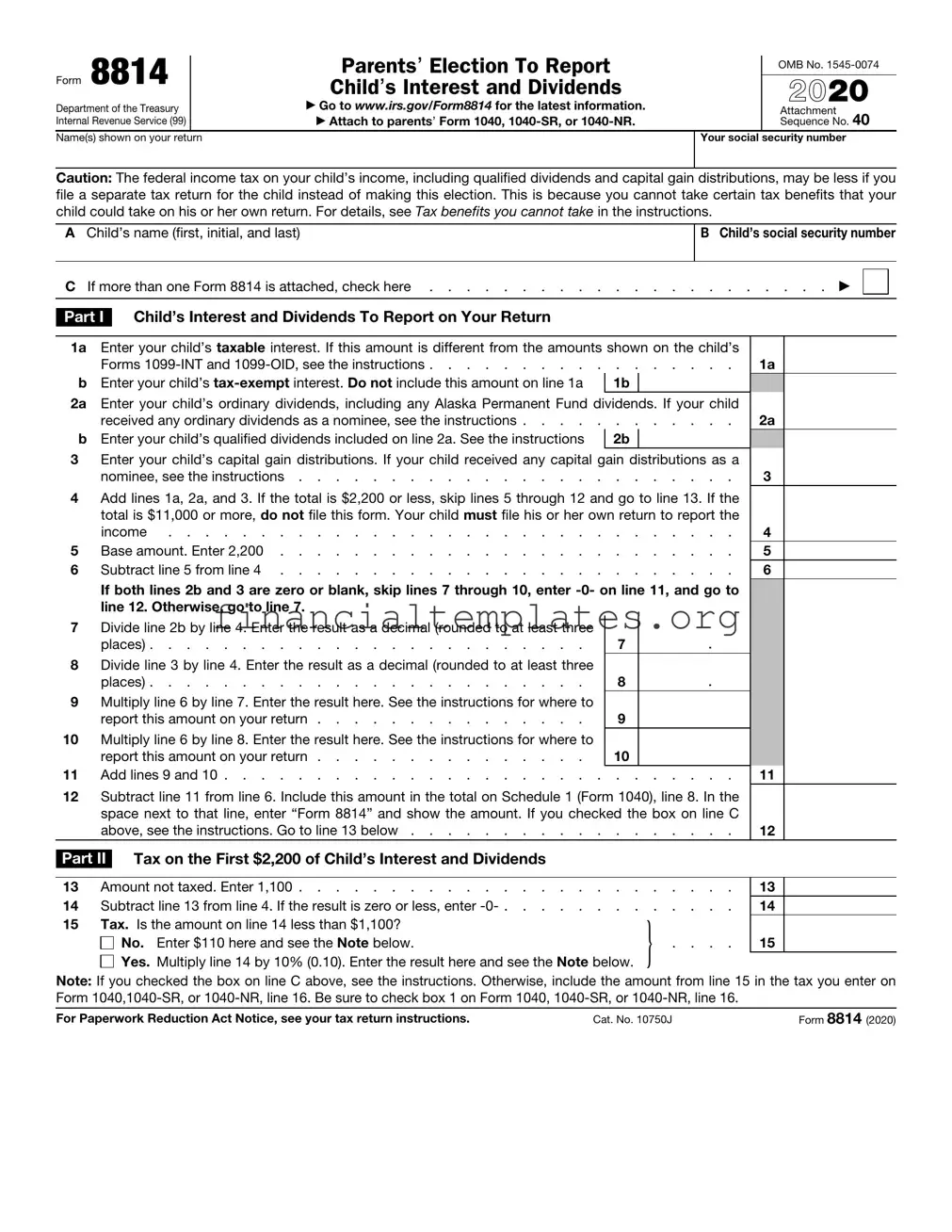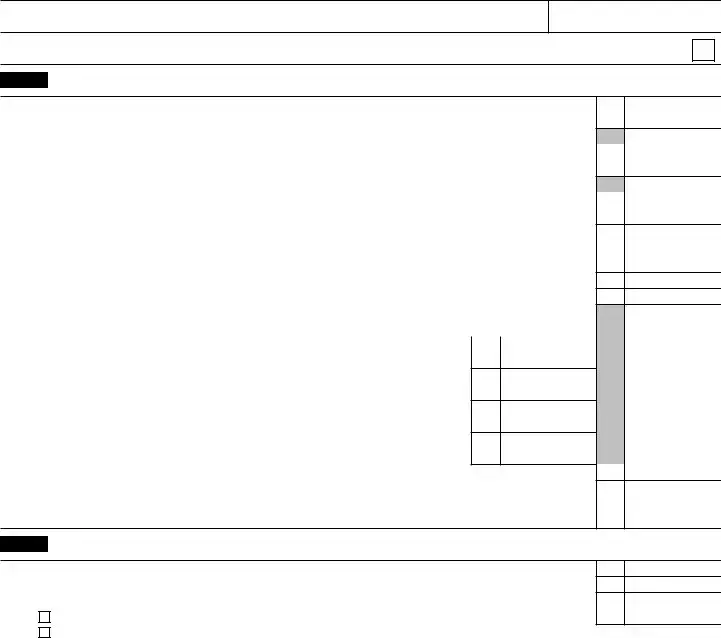General Instructions
Future Developments
For the latest information about developments related to Form 8814 and its instructions, such as legislation enacted after they were published, go to www.irs.gov/Form8814.
Purpose of Form
Use this form if you elect to report your child’s income on your return. If you do, your child will not have to file a return. You can make this election if your child meets all of the following conditions.
•The child was under age 19 (or under age 24 if a full-time student) at the end of 2021. “Student” is defined below.
•The child’s only income was from interest and dividends, including capital gain distributions and Alaska Permanent Fund dividends.
•The child’s gross income for 2021 was less than $11,000.
•The child is required to file a 2021 return.
•The child does not file a joint return for 2021.
•There were no estimated tax payments for the child for 2021 (including any overpayment of tax from his or her 2020 return applied to 2021 estimated tax).
•There was no federal income tax withheld from the child’s income.
You must also qualify. See Parents who qualify to make the election below.
Student. A student is a child who for some part of each of 5 calendar months during the year was enrolled as a full-time student at a school, or took a full-time, on-farm training course given by a school or a state, county, or local government agency. A school includes a technical, trade, or mechanical school. It does not include an on-the-job training course, correspondence school, or school offering courses only through the Internet.
Certain January 1 birthdays. A child born on January 1, 2003, is considered to be age 19 at the end of 2021. You cannot make this election for such a child unless the child was a full-time student.
A child born on January 1, 1998, is considered to be age 24 at the end of 2021. You cannot make this election for such a child.
How to make the election. To make the election, complete and attach Form(s) 8814 to your tax return and file your return by the due date (including extensions). A separate Form 8814 must be filed for each child whose income you choose to report.
Parents who qualify to make the election. You qualify to make this election if you file Form 1040, 1040-SR, or 1040-NR and any of the following apply.
•You are filing a joint return for 2021 with the child’s other parent.
•You and the child’s other parent were married to each other but file separate returns for 2021 and you had the higher taxable income.
•You were unmarried, treated as unmarried for federal income tax purposes, or separated from the child’s other parent by a divorce or separate maintenance decree. The child must have lived with you for most of the year (you were the custodial parent). If you were the custodial parent and you remarried, you can make the election on a joint return with your new spouse. But if you and your new spouse do not file a joint return, you qualify to make the election only if you had higher taxable income than your new spouse.
Note: If you and the child’s other parent were not married but lived together during the year with the child, you qualify to make the election only if you are the parent with the higher taxable income.
Tax benefits you cannot take. If you elect to report your child’s income on your return, you cannot take certain deductions that your child could take on his or her own return such as:
•Additional standard deduction of $1,700 if the child is blind,
•Penalty on early withdrawal of child’s savings, and
•Itemized deductions such as the child’s charitable contributions.
If your child received qualified dividends or capital gain distributions, you may pay up to $110 more tax if you make this election instead of filing a separate tax return for the child. This is because the tax rate on the child’s income between $1,100 and $2,200 is 10% if you make this election. However, if you file a separate return for the child, the tax rate may be as low as 0% (zero percent) because of the preferential tax rates for qualified dividends and capital gain distributions.
If any of the above apply to your child, first figure the tax on your child’s income as if he or she is filing a return. Next, figure the tax as if you are electing to report your child’s income on your return. Then, compare the methods to determine which results in the lower tax.
Alternative minimum tax. If your child received tax-exempt interest (or exempt-interest dividends paid by a regulated investment company) from certain private activity bonds, you must take this into account in determining if you owe the alternative minimum tax. This type of interest should be shown in box 9 of Form 1099-INT. See Form 6251, Alternative Minimum Tax—Individuals, and its instructions for details.
Net Investment Income Tax. For purposes of figuring any Net Investment Income Tax liability of the parents on Form 8960, the following rules apply.
1.All income reported on line 12 is included in the parents’ modified adjusted gross income, and
2.All net investment income included on line 12 (except for Alaska Permanent Fund dividends) is included in the parents’ net investment income.
For more information on Net Investment Income Tax, go to www.irs.gov/NIIT.
Investment interest expense. Your child’s income (other than qualified dividends, Alaska Permanent Fund dividends, and capital gain distributions) that you report on your return is considered to be your investment income for purposes of figuring your investment interest expense deduction. If your child received qualified dividends, Alaska Permanent Fund dividends, or capital gain distributions, see Pub. 550, Investment Income and Expenses, to figure the amount you can treat as your investment income.
Foreign accounts and trusts. You must complete Schedule B (Form 1040), Part III, and file it with your tax return if your child:
1.Had a foreign financial account, or
2.Received a distribution from, or was the grantor of, or transferor to, a foreign trust.
Enter “Form 8814” on the dotted line next to line 7a or line 8, whichever applies. Complete line 7b if applicable.
Note: If you file Form 8814 with your income tax return to report your child’s foreign financial account, you have an interest in the assets from that account and may be required to file Form 8938, Statement of Specified Foreign Financial Assets. See the Form 8938 instructions for details.
Change of address. If your child filed a return for a previous year and the address shown on the last return filed is not your child’s current address, be sure to notify the IRS, in writing, of the new address. To do this, use Form 8822, Change of Address.
Additional information. See Pub. 929, Tax Rules for Children and Dependents, for more details.
Specific Instructions
Name and social security number. If you are filing a joint return, enter both names but enter the social security number of the person whose name is shown first on the return.
Line 1a. Enter all taxable interest income your child received in 2021. Do not include tax-exempt interest in the total for line 1a, but be sure to include it on line 1b.

